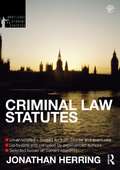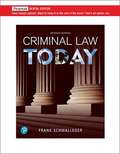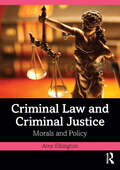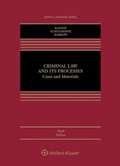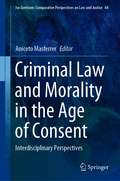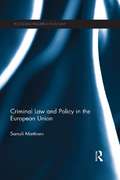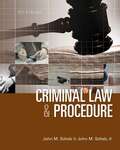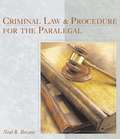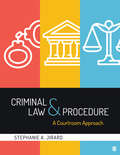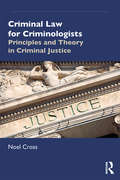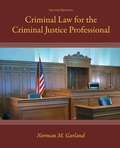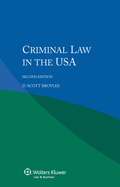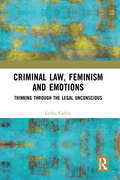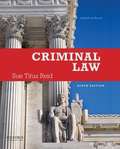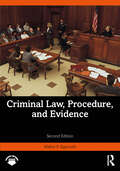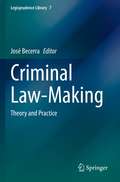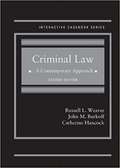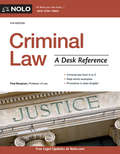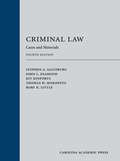- Table View
- List View
Criminal Law Statutes 2012-2013 (Routledge Student Statutes)
by Jonathan Herring‘Focused content, layout and price - Routledge competes and wins in relation to all of these factors’ - Craig Lind, University of Sussex, UK ‘The best value and best format books on the market.’ - Ed Bates, Southampton University, UK Routledge Student Statutes present all the legislation students need in one easy-to-use volume. Developed in response to feedback from lecturers and students, this book offer a fully up-to-date, comprehensive, and clearly presented collection of legislation - ideal for LLB and GDL course and exam use. Routledge Student Statutes are: • Exam Friendly: un-annotated and conforming to exam regulations • Tailored to fit your course: 80% of lecturers we surveyed agree that Routledge Student Statutes match their course and cover the relevant legislation • Trustworthy: Routledge Student Statutes are compiled by subject experts, updated annually and have been developed to meet student needs through extensive market research • Easy to use: a clear text design, comprehensive table of contents, multiple indexes and highlighted amendments to the law make these books the most student-friendly Statutes on the market Competitively Priced: Routledge Student Statutes offer content and usability rated as good or better than our major competitor, but at a more competitive price • Supported by a Companion Website: presenting scenario questions for interpreting Statutes, annotated web links, and multiple-choice questions, these resources are designed to help students to be confident and prepared.
Criminal Law Today (Fourth Edition)
by Frank Schmalleger Daniel E. Hall John J. DolatowskiThe fourth edition of Criminal Law Today presents a comprehensive, accessible, and up-to-date introduction to the basics of criminal law. The text provides students with the tools and information they need to gain an understanding of the fundamental nature of law, general legal principles, the historical development of criminal law, and its form and function in American society today. Key features are case excerpts that illustrate important legal themes in the context of the chapter topics.
Criminal Law and Criminal Justice: Morals and Policy
by Amy ElkingtonCriminal Law and Criminal Justice: Morals and Policy goes beyond the traditional criminal law textbook and invites students to question why we criminalise certain behaviour and whether the decisions made by the courts can be justified according to legal principle, morals and policy.Providing an overview not only of the legal doctrine of criminal law, but also of the underpinning theory behind the legal doctrine, the book encourages critical thinking around the context behind, and implementation of, legal decisions. It applies this to current issues, such as respect for personal autonomy, prevention of domestic abuse and discouraging gang activity, whilst providing a clear overview of the law relating to actus reus, mens rea, property offences, homicide, non-fatal offences, sexual offences, accessorial liability, and defences. Using hypothetical scenarios, students will develop an understanding of why certain rules exist and then be able to critically analyse why certain behaviour is criminalised. An in-depth study of several key cases will show how the rules and theory play out in practice, and students will examine how morals and policy have influenced these decisions.Featuring thinking points as well as further reading suggestions, this textbook is suitable for all students of criminal law, as well as for those studying jurisprudence.
Criminal Law and Its Administration (6th edition)
by Fred E. Inbau James R. Thompson James B. Zagel James P. ManakCriminal Law and Its Administration is designed specifically for criminal justice courses and sequences of courses covering both substantive and procedural criminal law. It uses the casebook method of instruction. It affords the opportunity for discussions as to the wisdom of the law as it now exists and the direction into which it may, or should be headed. Materials are presented in three parts: substantive criminal law, basic concepts regarding proof of guilt, and legal limitations upon law enforcement practices.
Criminal Law and Its Processes: Cases and Materials (Aspen Casebook)
by Sanford H. Kadish Stephen J. Schulhofer Rachel E. BarkowFrom a preeminent authorship team, Criminal Law and its Processes: Cases and Materials, Tenth Edition, continues in the tradition of its best-selling predecessors by providing students not only with a cohesive policy framework through which they can understand and examine the use of criminal laws as a means for social control but also analytic tools to understand and apply important criminal law doctrines. Instead of presenting the elements of various crimes in a disjointed fashion, Criminal Law and its Processes: Cases and Materials focuses on having students develop a nuanced understanding of the underlying principles, rules, and policy rationales that inform all criminal laws. A cases-and-notes pedagogy along with scholarly excerpts, questions, and notes, provides students with a rich foundation for not only the academic examination of criminal laws but also the application of the law to real-world scenarios.
Criminal Law and Its Processes: Cases and Materials (Ninth Edition)
by Sanford H. Kadish Stephen J. Schulhofer Rachel E. BarkowThis teaching guide helps law student students establish a solid foundation in the processes of criminal law and understanding of the problems within. This revised edition has enhanced details on group criminality, international human rights, human trafficking etc.
Criminal Law and Morality in the Age of Consent: Interdisciplinary Perspectives (Ius Gentium: Comparative Perspectives on Law and Justice #84)
by Aniceto MasferrerThis book discusses the relation between morality and politics, and morality and law, a field that has been studied for more than two thousand years The law is a part of human culture, and this touches upon a dynamic reality that is connected to the relation between nature and freedom, nature and culture. If such relations are not clearly understood, as is the case today, the relation between morality and law cannot be properly comprehended either. The relationship between morality and criminal law must constantly evolve to meet the needs of changing times and circumstances. Social changes and new situations require new answers. And since the relationship involves criminal law, legal philosophy and legal history, interdisciplinary approaches are always needed. Featuring fifteen original contributions by legal scholars from various European and American universities, the book does not pretend to solve the complexity of the relation between morality and criminal law, but instead expresses criticism, offers some proposals and stimulates further thought. The book tackles the topic from an interdisciplinary perspective (criminal law, constitutional law, legal philosophy and legal history, among others). As such, it appeals not only to scholars and students, but also to lawyers, policymakers, historians, theologians, philosophers and general readers who are interested in the legal, social, political and philosophical issues of our time.
Criminal Law and Policy in the European Union (Routledge Research in EU Law)
by Samuli MiettinenThis book takes stock of the development of EU criminal law from the establishment of the ECSC to the first European Union criminal law directives passed after the Lisbon Treaty. The work considers criminal offences established at EU level, the effects of EU law on national criminalization, the emerging body of EU criminal procedural law, and the increasing recognition of defense rights as EU rights. Limits to the legal effects of EU-level rules require them to be examined in the light of Member State practice. Implementing measures are not always appropriate, and may balance interests under national law, the rights of criminal defendants, and the need for EU-wide approximation. The proliferation of EU criminal law has led to an explicit, albeit underdeveloped, EU criminal policy This book will be of particular interest to students and scholars of EU Law and Criminal Law.
Criminal Law and Procedure
by John Scheb John Scheb IICRIMINAL LAW AND PROCEDURE is an effective resource for learning all substantive and procedural aspects of criminal law. This practical, up-to-date text features important updates to criminal laws and statutes in the post-9/11 world, including white-collar crime, cybercrime, terrorism, standards of proof, the PATRIOT Act, and much more.
Criminal Law and Procedure for the Paralegal
by Neal R. BevansDelving into one of the most fascinating areas of legal practice, this book shows the real world of prosecutors, defense attorneys and paralegals in criminal law. The author brings the study of criminal law alive. Actual examples of criminal cases are investigated and explained, defenses are explored, and appellate processes are examined.
Criminal Law and Procedure: A Courtroom Approach
by Stephanie A. JirardWritten by a former federal prosecutor and public defender, Criminal Law and Procedure: A Courtroom Approach introduces students to the essentials of criminal law and procedure by illuminating the legal issues justice professionals face before, during, and after a criminal trial. Through the examination of statutes, edited case excerpts, and recent constitutional interpretation of black letter law, the text bridges the gap between learning criminal procedure and applying criminal law. Drawing from author Stephanie A. Jirard’s vast experience in both the courtroom and the classroom, Criminal Law and Procedure gets students to think critically about real-world issues and practice applying the law in a just and meaningful way. Accessible and engaging, this text presents criminal law and procedure as an exciting opportunity to have a direct, positive impact on our communities and the criminal justice system. Key Features: "Making the Courtroom Connection" boxes help students apply the legal concepts they learn to real-life issues facing law enforcement, the court system, and correctional institutions today. Edited case excerpts connect criminal law and procedure with current case material on relevant topics so students can see the impact of judicial decision making. "Applying the Law to the Facts" boxes engage students’ critical thinking skills and enhance their logical problem-solving abilities by providing opportunities to apply the rule of law to different scenarios. "Springboard for Discussion" prompts spark conversations and invite students to contrast the moral, ethical, and legal implications of criminal law and procedure in a larger context. Problem-solving exercises at the end of each chapter provide students with opportunities to test themselves on the material before a formal assessment. Active Learning Exercises in the Instructor’s Manual enable professors to offer additional opportunities for experiential learning. Give your students the SAGE edge! SAGE edge offers a robust online environment featuring an impressive array of free tools and resources for review, study, and further exploration, keeping both instructors and students on the cutting edge of teaching and learning.
Criminal Law and Procedure: A Courtroom Approach
by Stephanie A. JirardWritten by a former federal prosecutor and public defender, Criminal Law and Procedure: A Courtroom Approach introduces students to the essentials of criminal law and procedure by illuminating the legal issues justice professionals face before, during, and after a criminal trial. Through the examination of statutes, edited case excerpts, and recent constitutional interpretation of black letter law, the text bridges the gap between learning criminal procedure and applying criminal law. Drawing from author Stephanie A. Jirard’s vast experience in both the courtroom and the classroom, Criminal Law and Procedure gets students to think critically about real-world issues and practice applying the law in a just and meaningful way. Accessible and engaging, this text presents criminal law and procedure as an exciting opportunity to have a direct, positive impact on our communities and the criminal justice system. Key Features: "Making the Courtroom Connection" boxes help students apply the legal concepts they learn to real-life issues facing law enforcement, the court system, and correctional institutions today. Edited case excerpts connect criminal law and procedure with current case material on relevant topics so students can see the impact of judicial decision making. "Applying the Law to the Facts" boxes engage students’ critical thinking skills and enhance their logical problem-solving abilities by providing opportunities to apply the rule of law to different scenarios. "Springboard for Discussion" prompts spark conversations and invite students to contrast the moral, ethical, and legal implications of criminal law and procedure in a larger context. Problem-solving exercises at the end of each chapter provide students with opportunities to test themselves on the material before a formal assessment. Active Learning Exercises in the Instructor’s Manual enable professors to offer additional opportunities for experiential learning. Give your students the SAGE edge! SAGE edge offers a robust online environment featuring an impressive array of free tools and resources for review, study, and further exploration, keeping both instructors and students on the cutting edge of teaching and learning.
Criminal Law for Criminologists: Principles and Theory in Criminal Justice
by Noel CrossCriminal Law for Criminologists uses theoretical and practical research to bridge the gap between ‘the law in the books’ (criminal law doctrine) and ‘the law in action’ (criminal justice process). It introduces the key policies and principles that drive criminal law in England and then explains the law itself in terms of relevant statute and case law. Starting with an outline of the basic principles and theories of criminal law and criminal justice, the author goes on to discuss: Criminal law and criminal justice in historical perspective, General principles of criminal law, including actus reus and mens rea, Specific types of criminal offence, including property, homicide, sexual, public order and drug offences, An overview of defences to crime, An appendix outlining essential legal skills. In examining the links between the worlds of criminal law and criminal justice, Criminal Law for Criminologists brings a fresh perspective to this field of research. Written in a clear and direct style, this book will be essential reading for students of criminology, criminal justice, law, cultural studies, social theory, and those interested in gaining an introduction to criminal law.
Criminal Law for the Criminal Justice Professional, Second Edition
by Norman M. GarlandCriminal Law for the Criminal Justice Professional, second edition, presents a complete basic introduction to the substance of those rules and laws that comprise the fabric of the criminal justice system in the United States. This text, like the first edition, describes the structure of the system, the theories underlying criminal responsibility, and the elements of specific crimes.
Criminal Law in the USA
by D. Scott BroylesDerived from the renowned multi-volume International Encyclopedia of Laws, this book provides a practical analysis of criminal law in the USA. <p><p>An introduction presents the necessary background information about the framework and sources of the criminal justice system, and then proceeds to a detailed examination of the grounds for criminal liability, the justification of criminal offences, the defences that diminish or excuse criminal liability, the classification of criminal offences, and the sanctions system. Coverage of criminal procedure focuses on the organization of investigations, pre-trial proceedings, trial stage, and legal remedies. A final part describes the execution of sentences and orders, the prison system, and the extinction of custodial sanctions or sentences. <p><p>Its succinct yet scholarly nature, as well as the practical quality of the information it provides, make this book a valuable resource for criminal lawyers, prosecutors, law enforcement officers, and criminal court judges handling cases connected with the USA. Academics and researchers, as well as the various international organizations in the field, will welcome this very useful guide, and will appreciate its value in the study of comparative criminal law.
Criminal Law, Feminism and Emotions: Thinking through the Legal Unconscious
by Latika VashistThis book critically engages criminal law issues relating to sexuality and violence in order to argue that an attention to emotions can produce a more nuanced, and more adequate, feminist account of legal subjectivity. Although the relationship between law and feminism has resulted in a vast body of work, the issue of emotions has not been foregrounded in feminist legal scholarship in India. Indeed, many feminists have argued that reason and not emotion must provide the foundational basis for all laws and legal reforms; an argument that has led to a division of the legal and the psychic or the emotional into separate and distinct zones. Challenging this separation, the book engages a range of recent criminal law cases and legislations in India in order to advocate for a ‘feminine’ law that embraces its inherent cracks and contradictions. Drawing on psychoanalytic theory, the book takes up a range of issues surrounding sexuality and violence in order to propose a shift from viewing law as reason to seeing law as the terrain of messy and contradictory emotional continuums; where legal subjects are viewed in their psychic dimensions, and where law itself is opened up to its own unconscious desires. Foregrounding emotions in this way, the book argues, can offer new insights into the operation of criminal law, and new orientations for feminist ways of responding to, and engaging with, it. This book will be of interest to scholars and students working in the areas of criminal law, legal feminism, and gender studies.
Criminal Law, Ninth Edition
by Sue Titus ReidOffering a unique modified case approach, Criminal Law, Ninth Edition, uses a wide sampling of federal and state statutes and cases to provide students with a comprehensive and contemporary introduction to the field. This ninth edition features the most recent relevant court decisions, especially those of the U.S. Supreme Court, along with current events and updates, where available, on topics retained from the previous edition.
Criminal Law, Philosophy and Public Health Practice
by John Coggon A. M. Viens A. M. Viens John Coggon Anthony S. KesselThe goal of improving public health involves the use of different tools, with the law being one way to influence the activities of institutions and individuals. Of the regulatory mechanisms afforded by law to achieve this end, criminal law remains a perennial mechanism to delimit the scope of individual and group conduct. Utilising criminal law may promote or hinder public health goals, and its use raises a number of complex questions that merit exploration. This examination of the interface between criminal law and public health brings together international experts from a variety of disciplines, including law, criminology, public health, philosophy and health policy, in order to examine the theoretical and practical implications of using criminal law to improve public health.
Criminal Law, Procedure, and Evidence
by Walter P. SignorelliProviding a complete view of U.S. legal principles, this book addresses distinct issues as well as the overlays and connections between them. It presents as a cohesive whole the interrelationships between constitutional principles, statutory criminal laws, procedural law, and common-law evidentiary doctrines. This fully revised and updated new edition also includes discussion questions and hypothetical scenarios to check learning. Constitutional principles are the foundation upon which substantive criminal law, criminal procedure law, and evidence laws rely. The concepts of due process, legality, specificity, notice, equality, and fairness are intrinsic to these three disciplines, and a firm understanding of their implications is necessary for a thorough comprehension of the topic. This book examines the tensions produced by balancing the ideals of individual liberty embodied in the Constitution against society’s need to enforce criminal laws as a means of achieving social control, order, and safety. Relying on his first-hand experience as a law enforcement official and criminal defense attorney, the author presents issues that highlight the difficulties in applying constitutional principles to specific criminal justice situations. Each chapter of the text contains a realistic problem in the form of a fact pattern that focuses on one or more classic criminal justice issues to which readers can relate. These problems are presented from the points of view of citizens caught up in a police investigation and of police officers attempting to enforce the law within the framework of constitutional protections. This book is ideal for courses in criminal law and procedure that seek to focus on the philosophical underpinnings of the system.
Criminal Law-Making: Theory and Practice (Legisprudence Library #7)
by José BecerraThis book intends to contribute to the consolidation of the new approach to lawmaking that has taken place in the last 20 years in legal philosophy and legal theory, spreading to other legal fields, especially criminal law. This new legislation science focusing on criminal problems has triggered a growing interest in the field, a dynamic which has led to a long-needed convergence of disciplines such as administrative law, criminal law, criminology, political science, sociology and, of course, legal philosophy to contribute to a more rational decision-making process for the construct of criminal laws. With the intention to continue on with the building of a solid “Criminal Legislation Science”, this work presents scholars, lawmakers and students various emblematic approaches to enrich the discussion about different and promising tools and theoretical frameworks.
Criminal Law: A Contemporary Approach (Interactive Casebook Ser.)
by Russell L. Weaver Catherine Hancock John M. BurkoffThis state-of-the-art casebook is both easy and fun to use. It is designed to give you the basis for an enjoyable, comprehensive learning experience for your students, providing you with the sort of piquing materials that should prompt interested and insightful classroom discussion. The focus here is on teach ability, rather than encyclopedic coverage of the field. Many modern, cutting-edge cases and related features are included, as well as the classic decisions, making it possible for you to show students the most current issues in the law and the traditional doctrinal underpinnings of this area. Numerous problem-style hypotheticals are also included throughout, serving to stimulate and encourage thought and discussion but also to help you focus your students on practice-oriented, analytical skills. The book also contains updated cases that bring the book entirely up-to-date.
Criminal Law: A Contemporary Approach (Interactive Casebook Series)
by Russell Weaver John Burkoff Catherine HancockThis state-of the-art casebook is both easy and fun to use. It is designed to give you the basis for an enjoyable, comprehensive learning experience for your students, providing you with the sort of piquing materials that should prompt interested and insightful classroom discussion. The focus here is on teachability, rather than encyclopedic coverage of the field. Many modern, cutting-edge cases and related features are included, as well as the classic decisions, making it possible for you to show students the most current issues in the law as well as the traditional doctrinal underpinnings of this area. Numerous problem-style hypotheticals are also included throughout, serving to stimulate and encourage thought and discussion but also to help you focus your students on practice-oriented, analytical skills.
Criminal Law: A Desk Reference
by Paul BergmanUnderstand criminal law! Learn your rights and how to protect yourself. Whether you face a criminal case, work in law enforcement, or simply want to know more about the criminal law system, this book can help. Criminal Law: A Desk Reference covers the basic to the complex in alphabetical order. Whether it’s “alibi” or “writ of habeas corpus,” the book makes it easy to find and understand what you’re looking for. It even provides links to articles about the law in your state. With this book you’ll be able to: learn the law with real-life examples understand procedures from arraignment through sentencing determine defenses to common crimes examine actual criminal statutes understand juvenile court know how appeals work, and learn how to work with a lawyer. This edition has been thoroughly updated to reflect the latest criminal law trends and Supreme Court rulings.
Criminal Law: Cases and Materials
by Stephen A. Saltzburg Kit Kinports John L. Diamond Thomas H. Morawetz Rory K. LittleThis book offers a comprehensive survey of the major concepts and doctrines in criminal law, describing both the common law and the Model Penal Code approaches to each issue. A unique feature of this book is that the cases used to illustrate major concepts are designed to be provocative and teachable. The facts of virtually every case lend themselves to creative teaching and lively class discussion and will stick in the memories of both instructor and students. Meanwhile, the lucidly organized notes following the cases deliver both doctrine and interesting highlights clearly and concisely. The new edition also incorporates the most recent significant cases and scholarship, including recent application of traditional criminal law concepts in more complex modern contexts such as white collar crime. Special features of the book include: the authors discuss recent criminal law cases in the news as well as contemporary debates on controversial criminal law issues such as rape and capital punishment; the book introduces and employs theoretical perspectives in a clear and accessible way. These materials encourage students to understand and apply various approaches to criminal law issues, including liberalism, feminism, critical race theory, and victims rights.
